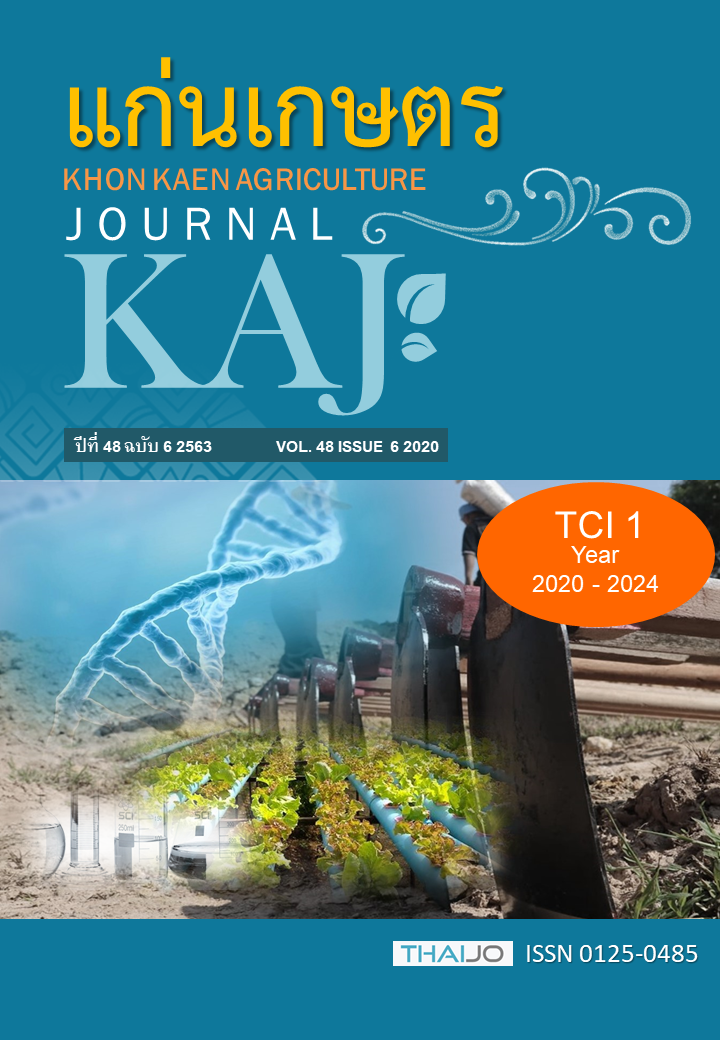การตอบสนองของข้าวขาวดอกมะลิ 105 ต่อแมกนีเซียมในดินนาต่างชนิดในภาคตะวันออกเฉียงเหนือของประเทศไทย
Main Article Content
บทคัดย่อ
ทำการศึกษาการตอบสนองของข้าวขาวดอกมะลิ 105 ในดินนาต่างชนิดได้แก่ ชุดดินพิมาย ชุดดินร้อยเอ็ด และชุดดินร้อยเอ็ดที่เป็นดินเค็มที่ได้รับแมกนีเซียมในอัตราที่แตกต่างกันได้แก่ 0, 1.5, 3, 6 และ 12 กก./ไร่ และทำการเปรียบเทียบวิธีการประเมินความเป็นประโยชน์ของแมกนีเซียมในดินสำหรับข้าว พบว่า การใส่แมกนีเซียมไม่มีผลต่อการเจริญเติบโตและองค์ประกอบผลผลิตทางสถิติแต่มีแนวโน้มเพิ่มผลผลิตเมล็ดและตอซังข้าวยกเว้นในชุดดินร้อยเอ็ดที่เป็นดินเค็ม การใส่แมกนีเซียมในทุกอัตราทำให้จำนวนเมล็ดดีในชุดดินร้อยเอ็ด 1 เพิ่มขึ้นอย่างมีนัยสำคัญทางสถิติ (ร้อยละ 86.6-88.6) ยกเว้นการในอัตรา 6 กก.Mg/ไร่ (ร้อยละ 80.3) นอกจากนี้การใส่แมกนีเซียมทำให้ข้าวดูดใช้ธาตุอาหารลดลงทางสถิติยกเว้นฟอสฟอรัสและแมกนีเซียม แมกนีเซียมในดินส่วนใหญ่อยู่ในรูปทั้งหมดซึ่งเป็นองค์ประกอบของแร่ (260-333 มก./กก.) และมีแมกนีเซียมที่สกัดได้แตกต่างกันตามชนิดน้ำยาสกัดดินโดย NH4OAC > CaCl2 > Mehlich III > น้ำกลั่น การขังน้ำเป็นระยะเวลา 1 เดือนทำให้แมกนีเซียมที่สกัดได้ลดลงแต่แมกนีเซียมทั้งหมดในดินมีสัดส่วนเพิ่มขึ้นซึ่งเป็นแหล่งสำรองของแมกนีเซียมต่อพืช แมกนีเซียมในดินไม่พบสหสัมพันธ์เชิงเส้นกับผลผลิตข้าว แต่แมกนีเซียมที่สกัดด้วย CaCl2 ในดิน (r=0.776**) และในดินสภาพน้ำขัง (r=0.748**) ต่างพบสหสัมพันธ์ทางสถิติกับความเข้มข้นของแมกนีเซียมในแกลบและรำ เช่นเดียวกับแมกนีเซียมในดินสภาพน้ำขังที่สกัดด้วยน้ำกลั่น (r=0.742**) และ CaCl2 (r=0.827**) ที่ต่างมีสหสัมพันธ์กับความเข้มข้นของแมกนีเซียมในเมล็ดข้าว สารสกัดทั้งสองจึงใช้ประเมินแมกนีเซียมสำหรับข้าวในดินเหล่านี้ได้ในระดับหนึ่ง
Article Details
References
กฤษณา สุดทะสาร. 2552. มาตรฐานข้าวไทย. ใน : การประชุมวิชาการข้าวและธัญพืชเมืองหนาวกลุ่มศูนย์วิจัยข้าวภาคตะวันออกเฉียงเหนือ ประจำปี 2553 วันที่ 26-28 เมษายน 2554 ณ โรงแรมอาราญาน่าภูพิมานรีสอร์ท อำเภอปากช่อง จังหวัดนครราชสีมา
จุลมณี ไพฑูรย์เจริญลาภ และจุรี ภัทรกุลนิษฐ์. 2552. ข้าวหอมมะลิ: การผลิตให้มีคุณภาพดีและ ผลผลิตสูง. พิมพ์ครั้งที่ 2 สำนักส่งเสริมการผลิตข้าว กรมการข้าว กระทรวงเกษตรและสหกรณ์, กรุงเทพฯ.
สำนักงานเศรษฐกิจการเกษตร. 2561. สถิติการเกษตรของประเทศไทยปี 2561. กระทรวงเกษตรและสหกรณ์
แสงนวล ทองเพียร และ อัมรา เวียงวีระ. 2548. ลักษณะพิเศษของข้าวหอมมะลิ. น.ส.พ. กสิกร 78: 6-11.
Basu, P.K. 2011. Methods Manual Soil Testing in India. Department of Agriculture & Cooperation Ministry of Agriculture Government of India.
Bergman, W. 1992. Nutritional Disorders of Plants. Jena, Germany: Gustav Fisher Verlag.
Blair, B.O. and H.S. Choguill. 1950. Comparison of methods for determination of soil calcium. Transansas Academic of Science 53: 23-27.
Brady, N.C. and R.R. Weil. 2016. The Nature and Properties of Soils. 15th Person, Prentice Hall, New York.
Brown, J.R. and D.D. Warncke. 1988. Recommended cation tests and measures of cation exchange capacity, pp.15–16. In: W.C. Dahnke, ed. Recommended Chemical Soil Test Procedures for the North Central Region. NCR Publ. No. 221 (Revised). Columbia, MO: Missouri Agricultural Experiment Station.
Cakmak, I. and H. Marschner. 1992. Magnesium deficiency and high light intensity enhance activities of superoxide dismutase, ascorbate peroxidase and glutathione reductase in bean leaves. Plant Physiol. 98: 1222-1227.
Christenson, D.R. and E.C. Doll. 1973. Release of magnesium from soil clay and silt fractions during cropping. Soil Sci. 116: 59-63.
Christenson, D.R., R.P. White and E.C. Doll. 1973 Yields and magnesium uptake by plants as affected by soil pH and calcium levels. Agron. J. 65:205-206.
Dobermann, A. and T. Fairhurst. 2000. Rice: Nutrient Disorders and Nutrient Management. Potash and Phosphate Institute. Canada.
Fageria, N.K. 2007. Yield physiology of rice. Journal of Plant Nutrition 30: 843-879.
Gransee, A. and H. Führs. 2013. Magnesium mobility in soils as a challenge for soil and plant analysis, magnesium fertilization and root uptake under adverse growth conditions. Plant and Soil 368: 5–21.
Land Classification Division and FAO Project Staff. 1978. Soil Interpretation Handbook for Thailand. Dept. of Land Development, Min. of Agri. And Coop., Bangkok.
Maguire, M. E. and J. A. Cowan. 2002. Magnesium chemistry and biochemistry. Bio Metals 15: 203-210.
Mayland, H. F. and S.R. Wilkinson. 1989. Soil Factors Affecting Magnesium Availability in Plant-Animal Systems: A Review. J. Animal Science 67: 3437-3444.
Mehlich, A. 1984. Mehlich 3 soil test extractant: A modification of Mehlich 2 extractant. Commun. Soil Sci. Plant Anal. 15: 1407-1416.
Mokwunye, A. and S.W. Melsted. 1972. Magnesium forms on selected temperate and tropical soils. Soil Sci. Soc. Amer. Proc. 36: 762-4.
Mokwunye, A.U. and S.W. Melstead.1972. Magnesium forms in selected temperate and tropical soils. Soil Sci. Soc. Amer. Proc. 36: 762–764.
Reuter, D.J., D.G. Edwards and N.S. Wilhelm.1997.Temperate and tropical crops. In: D.J. Reuter and J.B. Robinson, eds. Plant Analysis: an Interpretation Manual. CSIRO Publishing, Australia.
Sawyer, J.E., and A. Mallarino. 1999. Differentiating and understanding the Mehlich 3, Bray and Olsen soil phosphorus tests, p. 22-23. In: Proceedings of the University of Minnesota Crop Pest Management Short Course Program St. Paul, MN.
Schachtschabel, P. 1954. Das pflanzenverfügbare magnesiumdes bodens und seine bestimmung. J. Plant Nutr. Soil Sci. 67: 9-23.
Senbayram, M., A. Gransee, V. Wahle and H. Thiel. 2015. Role of magnesium fertilisers in agriculture: Plant-soil continuum. Crop Pasture Sci. 66: 1219-1229.
Spear. S.N., C.J. Asher and D.G. Edwards. 1978. Response of cassava, sunflower, and maize to potassium comcentration in solution. I. Growth and potassium concentration. Field Crops Res. 1: 347-361.
Staugaitis, G. and R. Rutkauskiene. 2010. Comparison of magnesium determination methods as influenced by soil properties. Zemdirbyste Agric. 97: 105-116.
Suswanto, T., J. Shamshuddin, S.R. Syed Omar, Peli Mat and C.B.S. Teh. 2007. Alleviating an acid sulfate soil cultivated to rice (Oryza sativa) using ground magnesium limestone and organic fertilizer. Jurnal Tanah Dan Lingkungan 9: 1-9.

